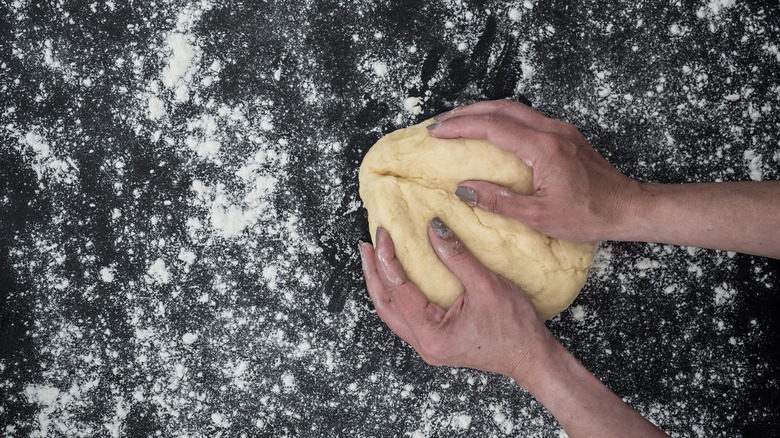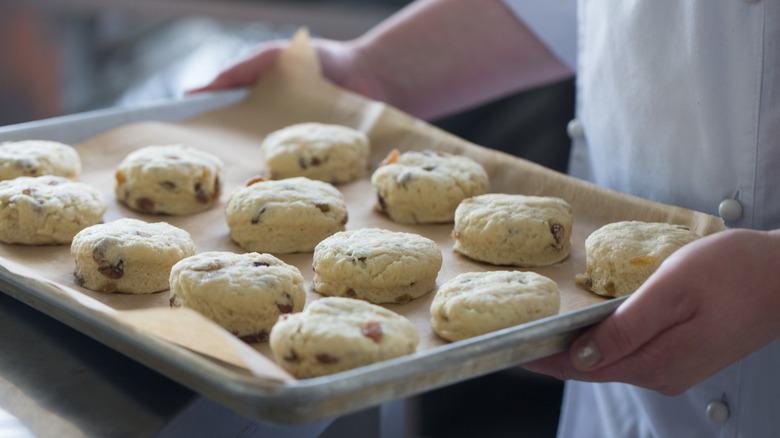The Moisture Tips To Remember Before Adding Fruit To Scones
Scones are quite the treat for any occasion. They're best eaten hot out of the oven, slathered with butter or a heaping dollop of fruit preserves. Whether topped with coarse sugar crystals or drizzled with a powdered sugar glaze, scones should have a crispy exterior with a flaky and tender, yet moist bite. The delicate crumbly (but not dry) textural balance of a scone is hard to achieve. And there are many factors that can make or break that consistency, including using cold butter, avoiding over-mixing, and ensuring the right ratio of wet to dry ingredients.
The fact that they aren't overly sweet makes scones the perfect canvas for adding fruit into the batter. Making scones with fresh, seasonal fruit, such as peaches in the summer, raspberries in the fall, or frozen fruit from the freezer, can be a great way to incorporate quality and flavor into your bakes.
Many fruity scone recipes call for using dried fruit, which helps avoid extra fruit juice throwing off the moisture-to-dry-ingredients ratio of your scone. However, to get all the flavor and quality benefits of fresh or frozen fruit, simply make sure your fruit is dry and any excess juice is removed before adding it into your scone batter.
Removing the extra liquid
The basic foundation of a scone is simple: flour, fat, and liquid. Making a scone batter involves grating and mixing cold butter into your dry ingredients and then incorporating wet ingredients (such as buttermilk, milk, and eggs), to make a crumbly, yet cohesive dough. The dough is then kneaded, rolled into a disk, chilled, and cut into wedges prior to baking.
While it may seem okay to add extra liquid from fruit into your scones (which are notoriously prone to going dense and dry), the trick to ideal scone dough is to add just enough liquid that the dough comes together. Too much liquid can cause the batter to become sticky and wet, which can cause over-development of the gluten (flour's protein structure), making the scones tough and dry. For this reason, it's crucial to prevent fruit from mashing and leaking excess liquid into the batter.
To add fresh fruit into your scones, avoid using overly juicy or overripe fruit and make sure to rinse, drain, and dry your fruit well. If you're using frozen fruit, there's no need to thaw it — it can be added directly into the batter from frozen. (This will also help keep the butter cold, aiding in the development of the flaky nature of the pastry.) If your frozen fruit is stuck together, it's okay to thaw the fruit to break it back into pieces. Just add the rinsing, draining, and drying step, similar to using the fresh stuff.
How to add fruit into scone batter
When adding fresh or frozen fruit to your scone batter, add it last — especially with frozen fruit — to prevent any unwanted thawing and melding of additional juices into the batter.
When you toss in your fruit, do so gently by folding the fruit into your batter with a spatula, just enough to incorporate it in and to avoid mashing any of the fruit and its liquids. You can even toss your fruit in a light dusting of flour prior to mixing it in. This helps to hold in some of the extra moisture and evenly distribute the fruit evenly by preventing it from dropping to the bottom of the batter.
A note of caution: some recipes call for puréeing a portion of fresh fruit, such as strawberries or raspberries, to give your scones a colorful tint. If you go this route, just remember to check the consistency of your batter and alter your liquid to dry ingredient ratio if needed to prevent the dough from becoming too wet, so your scones stay nice and tender.


